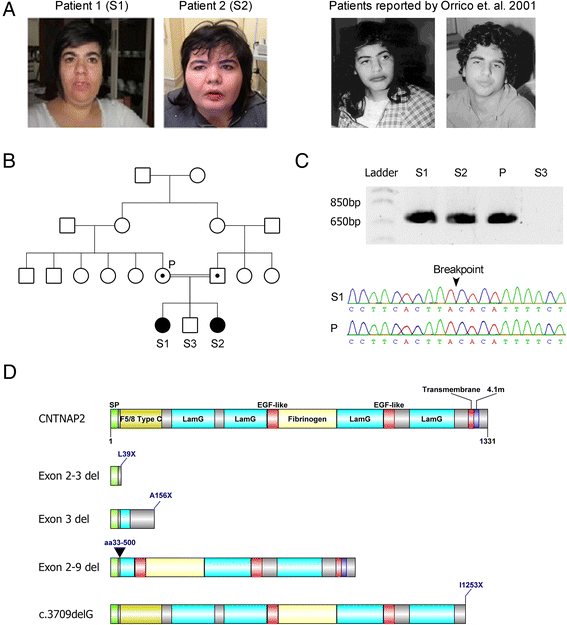Characterisation of CASPR2 deficiency disorder--a syndrome involving autism, epilepsy and language impairment
- PMID: 26843181
- PMCID: PMC4739328
- DOI: 10.1186/s12881-016-0272-8
Characterisation of CASPR2 deficiency disorder--a syndrome involving autism, epilepsy and language impairment
Abstract
Background: Heterozygous mutations in CNTNAP2 have been identified in patients with a range of complex phenotypes including intellectual disability, autism and schizophrenia. However heterozygous CNTNAP2 mutations are also found in the normal population. Conversely, homozygous mutations are rare in patient populations and have not been found in any unaffected individuals.
Case presentation: We describe a consanguineous family carrying a deletion in CNTNAP2 predicted to abolish function of its protein product, CASPR2. Homozygous family members display epilepsy, facial dysmorphisms, severe intellectual disability and impaired language. We compared these patients with previously reported individuals carrying homozygous mutations in CNTNAP2 and identified a highly recognisable phenotype.
Conclusions: We propose that CASPR2 loss produces a syndrome involving early-onset refractory epilepsy, intellectual disability, language impairment and autistic features that can be recognized as CASPR2 deficiency disorder. Further screening for homozygous patients meeting these criteria, together with detailed phenotypic and molecular investigations will be crucial for understanding the contribution of CNTNAP2 to normal and disrupted development.
Figures

Similar articles
-
Eight further individuals with intellectual disability and epilepsy carrying bi-allelic CNTNAP2 aberrations allow delineation of the mutational and phenotypic spectrum.J Med Genet. 2016 Dec;53(12):820-827. doi: 10.1136/jmedgenet-2016-103880. Epub 2016 Jul 20. J Med Genet. 2016. PMID: 27439707
-
Hyperkinetic stereotyped movements in a boy with biallelic CNTNAP2 variants.Ital J Pediatr. 2021 Oct 12;47(1):208. doi: 10.1186/s13052-021-01162-w. Ital J Pediatr. 2021. PMID: 34641913 Free PMC article.
-
Expanding the clinical spectrum associated with defects in CNTNAP2 and NRXN1.BMC Med Genet. 2011 Aug 9;12:106. doi: 10.1186/1471-2350-12-106. BMC Med Genet. 2011. PMID: 21827697 Free PMC article.
-
Clinical spectrum of KIAA2022/NEXMIF pathogenic variants in males and females: Report of three patients from Indian kindred with a review of published patients.Brain Dev. 2020 Oct;42(9):646-654. doi: 10.1016/j.braindev.2020.06.005. Epub 2020 Jun 27. Brain Dev. 2020. PMID: 32600841 Review.
-
Connecting the CNTNAP2 Networks with Neurodevelopmental Disorders.Mol Syndromol. 2015 Feb;6(1):7-22. doi: 10.1159/000371594. Epub 2015 Feb 3. Mol Syndromol. 2015. PMID: 25852443 Free PMC article. Review.
Cited by
-
Maternal-Autoantibody-Related (MAR) Autism: Identifying Neuronal Antigens and Approaching Prospects for Intervention.J Clin Med. 2020 Aug 7;9(8):2564. doi: 10.3390/jcm9082564. J Clin Med. 2020. PMID: 32784803 Free PMC article. Review.
-
The CNTNAP2-CASK complex modulates GluA1 subcellular distribution in interneurons.Neurosci Lett. 2019 May 14;701:92-99. doi: 10.1016/j.neulet.2019.02.025. Epub 2019 Feb 16. Neurosci Lett. 2019. PMID: 30779956 Free PMC article.
-
Intronic Variant in CNTNAP2 Gene in a Boy With Remarkable Conduct Disorder, Minor Facial Features, Mild Intellectual Disability, and Seizures.Front Pediatr. 2020 Sep 11;8:550. doi: 10.3389/fped.2020.00550. eCollection 2020. Front Pediatr. 2020. PMID: 33042910 Free PMC article.
-
Hyperexcitable and immature-like neuronal activity in the auditory cortex of adult rats lacking the language-linked CNTNAP2 gene.Cereb Cortex. 2022 Oct 20;32(21):4797-4817. doi: 10.1093/cercor/bhab517. Cereb Cortex. 2022. PMID: 35106542 Free PMC article.
-
Absence of Axoglial Paranodal Junctions in a Child With CNTNAP1 Mutations, Hypomyelination, and Arthrogryposis.J Child Neurol. 2018 Sep;33(10):642-650. doi: 10.1177/0883073818776157. Epub 2018 Jun 8. J Child Neurol. 2018. PMID: 29882456 Free PMC article.
References
-
- Fisher SE, Vernes SC. Genetics and the Language Sciences. Annu Rev Linguist. 2015;1(1):null. doi: 10.1146/annurev-linguist-030514-125024. - DOI
Publication types
MeSH terms
Substances
LinkOut - more resources
Full Text Sources
Other Literature Sources
Medical

